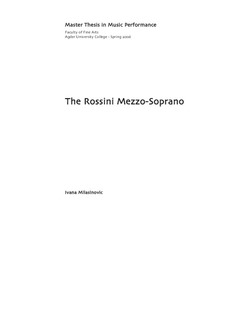| dc.contributor.author | Milasinovic, Ivana | |
| dc.date.accessioned | 2007-09-11T10:08:24Z | |
| dc.date.issued | 2006 | |
| dc.identifier.uri | http://hdl.handle.net/11250/138460 | |
| dc.description | Masteroppgave i utøvende musikk 2006 - Høgskolen i Agder, Kristiansand | en |
| dc.description.abstract | The Rossini mezzo-soprano is presented as a special voice type through the technical and
interpretative aspect. My observations based on personal experiences as well as the expertises of
my professors deal with the development of the mezzo-soprano voice with the influence of
pedagogy and also with the influence and comparison with their own voice possibilities.
The thesis is written in the English language by myself, Ivana Milasinovic and contains 54 pages.
This thesis is part of my Masters Degree programme at Agder University College, The
Conservatory of Music (Classical Department) in Kristiansand, Norway.
The study which I present is divided into ten sections.
Key words: Rossini, mezzo-soprano, singing technique.
The First Section is an introduction with methods and aim.
The Second Section is short introduction of Rossini and his works.
The Third Section contains general information about singing.
The Fourth Section is about vocal tuition; the technical approach to developing vocal skills to
perform Rossini’s music for the mezzo-soprano voice through the influence of teachers of singers
throughout history and also my own professors whose guidance have given me the basis of my
technique to support my professional career.
The Fifth Section contains technical observations about using of breath, palatal perception,
attack of tone, head tone, head resonances and chest resonance.
The Sixth Section is about challenge of Rossini’s demanding music – both for the student as well
3
as the teacher. This section relates to special technical aspects – such as the trill and coloratura
writing. I also include examples of technical exercises to ’warm up’ the voice in preparation for
practising and performing Rossini’s music.
The Seventh Section is about characteristics of the Rossini mezzo-soprano – a personal
observation of the type of voice that suits the composer’s challenging music.
The Eighth Section concentrates on the performance of Rossini’s operas, including three roles
(Rosina from Il Barbiere di Siviglia, Angelina from La Cenerentola, and Isabela from L’Italiana in
Algeri) with some annotations and music examples.
The Ninth Section is about Rossini’s singers - their vocal abilities and the views of the critics.
The Tenth Section contains a conclusion to my investigation. | en |
| dc.format.extent | 5461819 bytes | |
| dc.format.mimetype | application/pdf | |
| dc.language.iso | eng | en |
| dc.publisher | Høgskolen i Agder | |
| dc.publisher | Agder University College | |
| dc.subject.classification | MUK500 | |
| dc.subject.classification | MUR500 | |
| dc.title | The Rossini Mezzo-Soprano | en |
| dc.type | Master thesis | en |
| dc.subject.nsi | VDP::Humaniora: 0::Musikkvitenskap: 110::Musikkteori: 112 | |
| dc.subject.nsi | VDP::Humaniora: 0::Musikkvitenskap: 110::Annen musikkvitenskap: 119 | |
| dc.subject.nsi | VDP::Humaniora: 0::Musikkvitenskap: 110::Musikkpedagogikk: 114 | |
